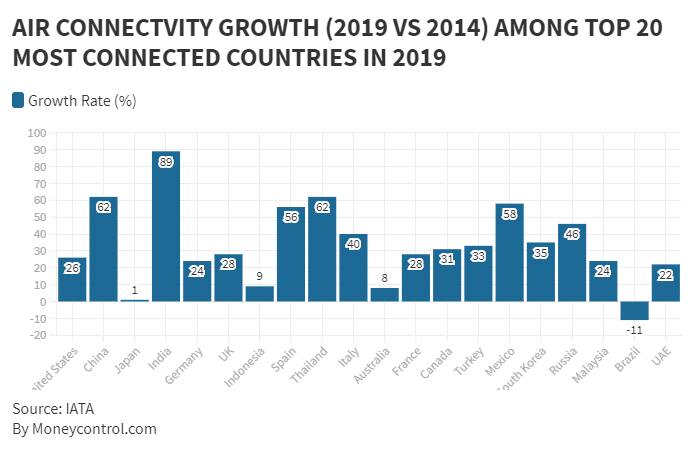December 09, 2020 / 20:57 IST
India reported the fastest air connectivity growth of 89 percent from 2014 to 2019, among the top 20 most connected countries in the world, according to the Air Connectivity report by International Air Transport Association (IATA) released in November 2020. India climbed up three places to fourth position in 2019 replacing Indonesia. The rise is attributed to the “significant growth in the Indian air transport sector–particularly in the domestic market segment”.The United States ranks first as the most connected country in the world, followed by China, Japan, India and Germany. Asia is the most connected region in the world, followed by North America. In terms of growth among the top 20 nations, India was followed by China and Thailand with 62 percent each, Mexico (58 percent) and Spain (56 percent).
Between 2014 and 2019, India’s connections to Asia-Pacific saw the fastest growth, and over the last 10 years, increasing the country’s air connectivity by 237 percent. “India’s incomes are increasing along with the proportion of middle-class households. Given these demographic trends, the India domestic market is currently the fastest growing one (measured in terms of revenue passenger kilometres),” the report said.Pointing out India’s success, the report highlights policy initiatives--such as the regional connectivity scheme (RCS)-UDAN and other development measures in safety and security, maintenance, repair and overhaul operations--that have played an important role in India’s growth.As many as 299 RCS-UDAN routes are operational ending November 2020, according to the official release. Of these, 207 are actually operational, Moneycontrol reported on December 8. To further energise India’s air connectivity links, the government has planned to add 100 new airports by 2024, which will include heliports and seaports as well. While India ranks fourth in absolute or total (which includes both international and domestic) connectivity, the country ranks ninth on the indicator for international air connectivity, up (38 percent growth) from 10th position in 2014.Air connectivity indicates how well a country is linked to cities around the world. The index measures the degree to which air transport connections support a country’s economic development and productivity levels, the report said. The connectivity indicator is based on annual seats available to each destination between 2014 and 2019.The report also measures air connectivity relative to the size of a country’s economy and population. Island states--such as Palau, Maldives and Aruba--report higher connectivity in terms of the size of their economies. The US ranks 45th after adjusting the GDP, China--90th and India--121. In terms of air connectivity per population, Aruba, Bahamas and Macau rank among the top three; the US ranks 24th, followed by China (81) and India (120).Impact of COVID-19 pandemic on air connectivityThe COVID-19 pandemic led to the grounding of the aviation sector across the globe, disrupting connectivity as countries moved into lockdowns restricting passenger movements and air travel fearing further the spread of the virus.Among the top five most connected countries in the world, India reported maximum (97 percent) “disruption” or decline in air connectivity levels in April 2020 over April 2019, according to IATA analysis. “In India, all domestic flights were suspended on March 25 for a period of two months, leading to an evaporation of connectivity during that period,” the report said.
Story continues below Advertisement
Germany was next (92 percent) to report the most disruption among the top five countries, followed by the United States (72 percent). In terms of regions, Africa (93 percent) and Europe (93 percent) were the most affected, while Asia-Pacific (76 percent) and North America (73 percent) fared relatively better.
However, with easing up of lockdowns and opening up of economies, "connectivity levels have been recovering but are still below the pre-pandemic levels."
“Prior to the COVID-19 pandemic, the growth in air connectivity was a global success story. Over the last two decades the number of cities directly linked by air (city-pair connections) more than doubled while over the same period, air travel costs fell by around half,” the IATA release said.Among the top 20 most connected cities in Asia-Pacific, Delhi (56 percent) and Mumbai (43 percent) have reported “substantial” increase in their connectivity levels from 2014 to 2019, expanding their routes between Europe-India-Southeast Asia. London was the most connected city in the world in 2019, followed by Shanghai, Beijing, New York and Tokyo. This changed as a result of the pandemic with London reporting 67 percent decline in connectivity in September 2020 over September 2019. Shanghai is now ranked at the top followed by Beijing, Guangzhou, Chengdu and Chicago. Discover the latest Business News, Sensex, and Nifty updates. Obtain Personal Finance insights, tax queries, and expert opinions on Moneycontrol or download the Moneycontrol App to stay updated!




